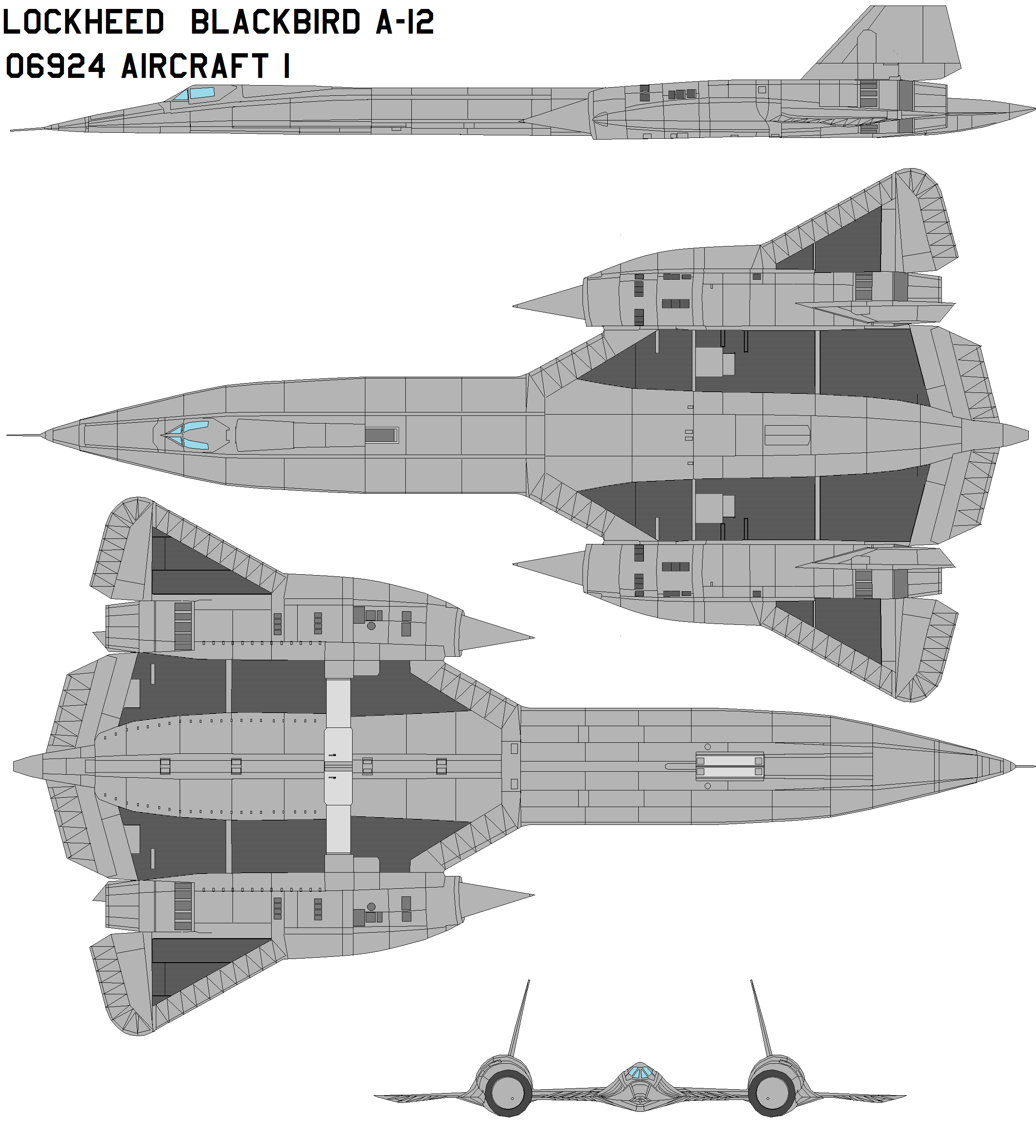Archangel 12 Plane - The Lockheed A-12 is a Mach 3+ high-altitude reconnaissance aircraft built for the United States Intelligence Agency (CIA) by Lockheed's Skunk Works, based on designs by Clarce "Kelly" Johnson. The aircraft was designated A-12, the 12th in a series of internal design work for "Archangel", the aircraft's internal codename. In 1959 it was selected from Convair's FISH and Kingfish designs as the winner of Project GUSTO and was developed and operated under Project Oxcart.
CIA officials initially favored the Convair design because of its smaller radar diameter, but the A-12's specifications were slightly better and its projected cost was much lower. The performances of individual companies were decisive. Convair's work on the B-58 was plagued by delays and cost overruns, while Lockheed produced the U-2 on time and under budget. In addition, Lockheed had experience in managing a "black" project.
Archangel 12 Plane

The A-12 was produced from 1962 to 1964 and flew from 1963 to 1968. It was the forerunner of the US Air Force YF-12 two-seat interceptor prototype, the M-21 launcher for the D-21 drone, and the SR -71 Blackbird, a slightly longer variant capable of carrying heavier fuel and camera payloads. The A-12 began flying missions in 1967, with its final mission in May 1968; the program and aircraft were withdrawn in June. The program was officially unveiled in the mid-1990s.
Elon Musk And His Partner Grimes Name Their Newborn After The A 12 Spy Plane
A CIA official later wrote, "Oxcart was chosen from a random list of codes to mark this research and development and all subsequent work on the A-12. The aircraft itself also began to become so."
After the failure of the CIA's Rainbow Project to reduce the U-2's radar cross section (RCS), initial work began at Lockheed in late 1957 to develop another aircraft to fly over the Soviet Union. Designer Kelly Johnson said, "I remember having long discussions in April 1958 with [CIA's Assistant Director of Plans] Richard Bissell about whether the U-2 should be a successor." We agreed ... that there should be one more round before satellites make aerial reconnaissance obsolete for clandestine reconnaissance."
Under Project Gusto, the projects were nicknamed "Archangel", after the U-2 program, which was known as "The Angel". As aircraft designs evolved and configurations changed, Lockheed's internal designation changed from Archangel-1 to Archangel-2, and so on. These evolving design names soon became known simply as "A-1", "A-2", etc.
These projects reached phase A-11 where the program was revised. The A-11 competed with Convair's Kingfish proposal, with more or less similar performance. However, Kingfish included a number of features that significantly reduced its RCS, which were seen as beneficial to the board. Lockheed responded with a simple update of the A-11, adding twin diagonal fins instead of one rectangular one, and adding several non-metallic material areas. This became the A-12 project. On January 26, 1960, the CIA ordered 12 A-12s.
A 12 Oxcart Vs Sr 71 Blackbird
Since the A-12 was way ahead of its time, many new technologies had to be developed specifically for the Oxcart project, with some being in use within a day. One of the biggest problems engineers faced at the time was working with titanium.
In his book Skunk Works: A Personal Memoir of My Years at Lockheed, B. Rich said: "Our supplier, Titanium Metals Corporation, had only limited reserves of this precious alloy, so the CIA began a worldwide search with third parties and fake companies. . managed to inadvertently buy base metal from one of the world's leading exporters - the Soviet Union. The Russians never had any idea how they had really contributed to the creation of an airplane headed to a construction site rushed to spy on their homeland.
Prior to the A-12, titanium was used only in high-temperature exhaust hoods and other small parts directly related to the support, cooling, or formation of high-temperature areas in aircraft, such as those exposed to the greatest kinetic heating of the air stream, such as wing leading edges . However, the A-12 is mostly constructed of titanium. Titanium is quite stiff and difficult to work with, which made it difficult to form into curves using available techniques. This made it difficult to form wing leading edges and similar surfaces. The solution was found by machining only small "rounds" of material of the required shape and gluing them to the underlying framework, which was more linear. A good example is on the wing; the basic frame of spars and stringers butted together, leaving triangular cutouts along the leading edge filled with fillets.

With the transition to the A-12, another improvement was made to the RCS, replacing the fillets with new radar-absorbing composite materials made of iron ferrite and silicon laminate, both bonded with asbestos to absorb radar signals and increase aircraft stealth .
Lockheed A 12
After development and production at the Skunk Works in Burbank, California, the first A-12 was moved to the Groom Lake Test Facility (Area 51).
On April 25, 1962, it made its first (unofficial and unannounced) flight with Lockheed test pilot Louis Schalk at the controls.
The first official flight took place on April 30, followed by another supersonic flight on May 4, 1962, reaching Mach 1.1 at 40,000 feet (12,000 m).
The first five A-12s, in 1962, were initially flown with 17,000 lbf (76 kN) Pratt & Whitney J75 engines
Lockheed Yf 12a > National Museum Of The United States Air Force™ > Display
Each, allowing A-12s equipped with the J75 to reach speeds of about Mach 2.0. On October 5, 1962, with newly developed J58 gin, the A-12 flew one J75 gin and one J58 gin. By early 1963, A-12s were flying with J58 engines, and by 1963 these A-12s equipped with J58s were reaching speeds of Mach 3.2.
Collins ejected safely, wearing a standard flight suit and avoiding unwanted questions from the truck driver who picked him up. He called Area 51 of the Highway Patrol office.
The response to the disaster illustrates the mystery and importance of the project. The CIA called the aircraft the Republic F-105 Thunderchief in press articles and official documents.

Two nearby farmers were told that the plane was carrying nuclear weapons to prevent them from approaching the crash site;
Top Secret Spy Planes Developed At Area 51
And local law enforcement and the passing family were strongly warned to keep quiet about the disaster. They were also each paid $25,000 in cash to do so; the project often used such cash payments to avoid external investigations into its operations. The project received sufficient funding; contracted bodyguards were paid $1,000 a month with free housing on base, and Las Vegas chefs were available 24/7 for steaks, Maine lobster or other orders.
A total of 18 aircraft were built under the production program. Of these, 13 are A-12s, three are prototype YF-12A interceptors for the US Air Force (not funded by the OXCART program), and two are M-21 reconnaissance drone carriers. One of the 13 A-12s was a dedicated training aircraft with a second seat, placed behind the pilot and raised so the instructor pilot could look forward. Known as the "Titanium Goose", the A-12 trainer retained the J75's powertrains for the life of the tires.
Three more A-12s were lost in later tests. On July 9, 1964, Article 133 crashed on final approach to the runway when the servo controller froze at 500 feet (150 m) at 200 knots (230 mph; 370 km/h), causing it to roll smoothly to the left. Lockheed test pilot Bill Park was unable to overcome the role. At a bank angle of approximately 45 degrees and an altitude of 200 feet (61 m), he ejected and was ejected sideways from the aircraft. Although not very high above the ground, his parachute opened and he landed safely.
On December 28, 1965, a third A-12 was lost when "Section 126" crashed 30 seconds after takeoff, followed by a series of rapid yaws and pitches that rendered the aircraft uncontrollable. Mele Vojvodich was supposed to take aircraft number 126 on a test flight, which included a test of a rdezvous beacon with a KC-135 tanker, and managed to eject safely to an altitude of 150 to 200 feet (46 to 61 m) above the ground. The post-accident investigation concluded that the main cause of the accident was a maintenance error; the airline's electrician mistakenly switched the wiring connections connecting the yaw and pitch gyroscopes of the stability stabilization system to the control surface servos, meaning that control inputs that commanded pitch changes counterintuitively caused the aircraft to yaw and instead the left - or right yaw control to control signals to the right changed the angle of the aircraft. The investigation criticized the negligence of the electrician, but also pointed to flaws in the supervision of maintenance activities and the fact that the plane's design allowed the replacement of connectors in the first place.
History — Mach3ti.com
The Oxcart program's first fatality occurred on January 5, 1967, when "Section 125" crashed, killing CIA pilot Walter Ray when the plane ran out of fuel while landing at a test range. The exact cause of the loss could not be determined, and it was considered most likely that a fuel metering error had led to the fuel
Stanley 12 220 block plane, stanley 12 scraper plane, 12 passenger plane for sale, stanley 12 204 plane, stanley no 12 scraper plane, 12 passenger plane, x plane 12, pc 12 plane, stanley 12 plane, pc 12 plane for sale, archangel plane, archangel 12

0 Comments